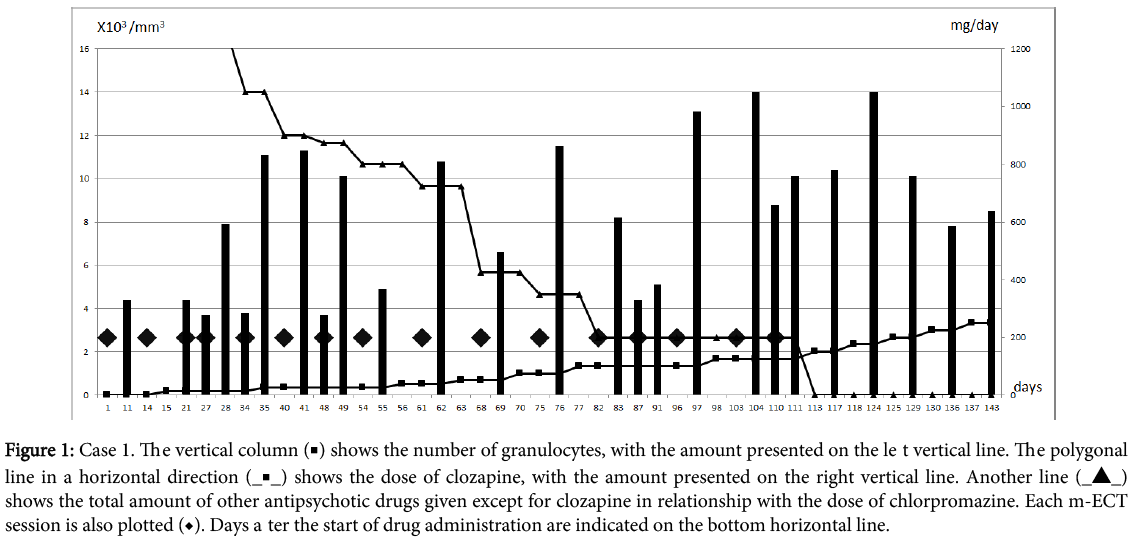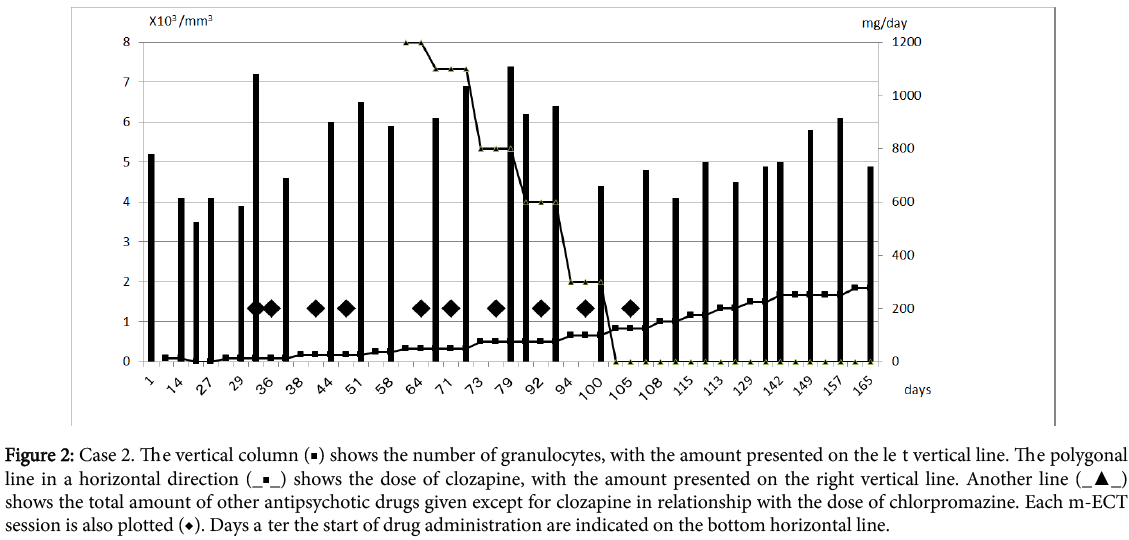Clinical Findings Showing that Non-Convulsive Electric Shock Administration for Patients Receiving Clozapine Therapy for Schizophrenia May Contribute to Stability of Granulocyte Number, the Most Critical Drug Side-Effect
Received: 09-Jan-2017 / Accepted Date: 11-Feb-2017 / Published Date: 20-Feb-2017
Abstract
Two treatment-resistant schizophrenic patients were administered clozapine, but showed a decrease in granulocytes. As an alternative treatment, we administered non-convulsive Electric Shock Therapy (ECT) (modified- ECT: m-ECT) to both and the number of granulocytes increased to a level considered safe for clozapine ingestion. Then, under continuation of m-ECT, we gradually increased the dose of the drug. After 10-14 m-ECT sessions in both patients, the number of granulocytes became stable at approximately 5000/mm3 and m-ECT was completed. Our findings show the possibility of treatment for therapy-resistant patients who are unable to receive clozapine because of reduced granulocyte number.
Keywords: Clozapine therapy; Electric shock; Schizophrenia; Granulocytes
16300Introduction
Schizophrenia is a common psychotic disorder that severely affects human personality, mainly in the manner of thinking; including delusions, inappropriate hostility, strange behaviour, and others, with no proven cure. Although side-effects have been shown, clozapine has been recently reintroduced as drug therapy for the disorder because of its remarkable effects on normalizing personality (improved rapport, control of hostility increased quality of life, etc.) [1]. However, an unfavourable effect of clozapine administration is a decrease in granulocytes, especially neutrocytes, which leads to a large portion of candidates not able to use the drug [2].
Non-convulsive Electroconvulsive Therapy (ECT) and modified ECT (m-ECT) have been introduced widely for daily psychiatric therapy. Although ECT is generally used for mood disorders, it has also been applied for controlling schizophrenic psychomotor excitement and other unexplainable actions by patients [3]. M-ECT is generally preferred as compared to ECT, because the electric shock can be applied without resultant convulsions.
In the present study, we report results of 2 patients who received m- ECT while being administered clozapine because of concern regarding the instability of granulocyte numbers. Both showed improvement in granulocytes, which enabled safe use of clozapine with favourable effects. In addition, we discuss this combined therapy as a means for more wide use of clozapine for therapy-resistant patients and the mechanism of its effects.
Case 1: Male, 31 Years Old, Hebephrenic Schizophrenia
Three years prior, the patient was admitted for deterioration of personality (difficult to communicate with others due to meaningless language, inappropriate responses, discontinuation of medication or nutrition, delusions including personal odor, etc.).
Moreover, unexpected hostility had led him to management in an isolated protection room for approximately 3 years regardless of medication, including nearly all available atypical antipsychotic drugs.
We decided to start clozapine administration. However, after starting the drug at 12.5 mg per day, granulocytes decreased to less than 4000/mm3, which required blood tests twice a week. As an additional therapy, we also began m-ECT (450 V sin implus, 0.2-0.45 × 504 mC) for relaxation of the cumbersome symptoms. Unexpectedly, while clozapine administration continued, blood tests conducted after starting m-ECT showed that granulocytes recovered to approximately 10,000/mm3 .
Thus, we decided perform blood testing on the day following the m- ECT sessions, which continued for approximately 3 months. As a result, the patient was able to socialize with other patents outside of the protection room and was freed from his self-smell delusion. As compared to prior to beginning clozapine and m-ECT therapy, the Positive and Negative Symptom Scale (PANSS) score decreased from 121 to 92. Presently, m-ECT is not being given and clozapine administration is continuing without a decrease in granulocytes (Figure 1).
Figure 1:Case 1. The vertical column (?) shows the number of granulocytes, with the amount presented on the le t vertical line. The polygonalline in a horizontal direction (_?_) shows the dose of clozapine, with the amount presented on the right vertical line. Another line (_?_) shows the total amount of other antipsychotic drugs given except for clozapine in relationship with the dose of chlorpromazine. Each m-ECT session is also plotted (?). Days a ter the start of drug administration are indicated on the bottom horizontal line.
Case 2: Female, 51 Years Old, Delusional Schizophrenia
The patient had been suffering from delusional schizophrenia for more than 30 years. In the early period, personality deterioration was not apparent and with antipsychotic drugs she was able to function as a housewife.
However, recently the patient began to show difficulty with maintaining regular daily life due to delusional thinking, such as the feeling that someone was intruding into her house, and was unable to maintain regular drug administration. In addition, she showed bizarre behaviour such as going out of the house without wearing clothes. After noting no satisfactory effects from therapy with more than 2 types of atypical antipsychotics, we decided to begin an administration of clozapine. In the early period of clozapine therapy, the patient was unable to get along with other patients and stayed in an isolated protection room. Moreover, granulocytes showed a decreasing trend to less than 4000/mm3.
However, we were concerned about discontinuation of drug therapy and decided to start m-ECT (450 V sin impulse, 0.2-0.45 × 504 mC) sessions while maintaining a minimum dose of clozapine. Thereafter, granulocytes increased and stabilized at greater than 5000/mm3 and her fear of other people gradually disappeared.
Following 10 sessions of m-ECT, the patient began to participate in regular daily life in the hospital without apparent side-effects from the drug, thus we stopped m-ECT and administration of antipsychotics other than clozapine. As compared to prior to beginning clozapine and m-ECT therapy, the PANSS score decreased from 109 to 79, while granulocytes have been maintained at a safe level (>5000/mm3) (Figure 2).
Figure 2:Case 2. The vertical column (?) shows the number of granulocytes, with the amount presented on the le t vertical line. The polygonal line in a horizontal direction (_?_) shows the dose of clozapine, with the amount presented on the right vertical line. Another line (_?_) shows the total amount of other antipsychotic drugs given except for clozapine in relationship with the dose of chlorpromazine. Each m-ECT session is also plotted (?). Days a ter the start of drug administration are indicated on the bottom horizontal line.
Discussion
The present 2 patients were treated with m-ECT as an alternative complementary therapy method. Although the combined use of m- ECT and clozapine therapy had been reported in our country, the report did not inform us of the benefit gain from the combination [4]. Our results do not provide concrete evidence for the effects of m-ECT in patients receiving clozapine. Nevertheless, it is possible that such combined therapy decreases stress induced by drug therapy shown by a reduction in number of granulocytes.
Previous studies have found that ECT enhances immunological ability in humans. For example, it was reported that the activity of the natural killer granulocytes was activated or the number of leukocytes slightly increased [5,6]. However, to the best of our knowledge, no reports have directly shown an increase in number of granulocytes or the mechanisms of that phenomenon. The capability for ECT to enhance immunological ability remains speculative, though cytokine family members show changes in amount in blood and are candidates for maintaining the number of granulocytes [7].
An increase in number of granulocytes by m-ECT remains to be proven. Furthermore, the mechanisms by which an electric shock affects the immunological system, how long the increase in number of granulocytes persists, and whether the phenomenon observed in our patients is universal are not apparent.
Should clozapine be considered as the last choice for therapyresistant schizophrenic patients, safer use must be investigated? We used the present combined therapy in 2 therapy-resistant patients who could not continue the drug because of a decrease in granulocytes along with continuation of symptoms and requirement of complementary therapy. Although the number of subjects was small, a recovery of the number of granulocytes was observed in each. In a future report, we intend to present additional information regarding these cases. For that purpose, more several cases were given the therapy that combined m-ECT and clozapine administration. First of all, we intended to know how long does it take for the patients showing the decrease of granulocyte to stabilize its number by m-ECT therapies. Moreover, if m-ECT increases the granulocytes, it should be apparent when the effect emerges after the therapy is done. We now are planning the multiple measurements of the number under permission by the patients. Furthermore, influences on the amount of candidate substances including cytokine families by m-ECT will be studied. On the other hand, the genome risk factors for Clozapine-Induced Granulocytopenia (CIG) are gradually reported. Iwata and colleague recently presented the specific risk factor Japanese patients [8]. Therefore, in the future we’ll have to try research about the genome risk factors for CIG of patients who were done the combined therapy successfully to clarify the relation between the risk factor and our combined therapy.
References
- Azorin JM, Spiegel R, Remington G, Vanelle JM, Péré JJ, et al. (2001) A double-blind comparative study of clozapine and risperidone in the management of severe chronic schizophrenia. Am J Psychiatry 158:1305-1313.
- Copolov DL, Bell WR, Benson WJ, Keks NA, Strazzeri DC, et al. (1998) Clozapine treatment in Australia: a review of haematological monitoring. Med J Aust 168: 495-497.
- Chanpattana W, Kramer BA (2003) Acute and maintenance ECT with flupenthixol in refractory schizophrenia: sustained improvements in psychopathology, quality of life, and social outcomes. Schizophr Res 63: 189-193.
- Enomoto T, Ito T, Sekine K, Yasui R, Ashizawa Y, et al. (2013) Clinical experience with clozapine in 55 cases of treatment-resistant schizophrenia. Seishin Shinkeigaku Zasshi 115: 953-966.
- Chaturvedi S, Chadda RK, Rusia U, Jain N (2001) Effect of electroconvulsive therapy on hematological parameters. Psychiatry Res 104: 265-268.
- Kronfol Z, Nair MP, Weinberg V, Young EA, Aziz M (2002) Acute effects of electroconvulsive therapy on lymphocyte natural killer cell activity in patients with major depression. J Affect Disord 71: 211-215.
- Zincir S, Öztürk P, Bilgen AE, ?zci F, Yükselir C (2016) Levels of serum immunomodulators and alterations with electroconvulsive therapy in treatment-resistant major depression. Neuropsychiatr Dis Treat 12:1389-1396.
- Saito T, Ikeda M, Mushiroda T, Ozeki T, Iwata N, et al. (2016) Pharmacogenomic Study of Clozapine-Induced Agranulocytosis/Granulocytopenia in a Japanese Population. Biol Psychiatry 80: 636-642.
Citation: Sugita K, Mori Y, Kanemoto K, Sugita S (2017) Clinical Findings Showing That Non-Convulsive Electric Shock Administration for Patients Receiving Clozapine Therapy for Schizophrenia May Contribute to Stability of Granulocyte Number, the Most Critical Drug Side-Effect. J Neuropsychopharmacol Mental Health 2: 115.
Copyright: © 2017 Sugita K, et al. This is an open-access article distributed under the terms of the Creative Commons Attribution License, which permits unrestricted use, distribution, and reproduction in any Smedium, provided the original author and source are credited.
Select your language of interest to view the total content in your interested language
Share This Article
Recommended Journals
Open Access Journals
Article Usage
- Total views: 7812
- [From(publication date): 0-2017 - Aug 11, 2025]
- Breakdown by view type
- HTML page views: 6824
- PDF downloads: 988


